Evolution of Cell Wall Polymers in Tip-Growing Land Plant Gametophytes: Composition, Distribution, Functional Aspects and Their Remodeling
- PMID: 31057570
- PMCID: PMC6482432
- DOI: 10.3389/fpls.2019.00441
Evolution of Cell Wall Polymers in Tip-Growing Land Plant Gametophytes: Composition, Distribution, Functional Aspects and Their Remodeling
Abstract
During evolution of land plants, the first colonizing species presented leafy-dominant gametophytes, found in non-vascular plants (bryophytes). Today, bryophytes include liverworts, mosses, and hornworts. In the first seedless vascular plants (lycophytes), the sporophytic stage of life started to be predominant. In the seed producing plants, gymnosperms and angiosperms , the gametophytic stage is restricted to reproduction. In mosses and ferns, the haploid spores germinate and form a protonema, which develops into a leafy gametophyte producing rhizoids for anchorage, water and nutrient uptakes. The basal gymnosperms (cycads and Ginkgo) reproduce by zooidogamy. Their pollen grains develop a multi-branched pollen tube that penetrates the nucellus and releases flagellated sperm cells that swim to the egg cell. The pollen grain of other gymnosperms (conifers and gnetophytes) as well as angiosperms germinates and produces a pollen tube that directly delivers the sperm cells to the ovule (siphonogamy). These different gametophytes, which are short or long-lived structures, share a common tip-growing mode of cell expansion. Tip-growth requires a massive cell wall deposition to promote cell elongation, but also a tight spatial and temporal control of the cell wall remodeling in order to modulate the mechanical properties of the cell wall. The growth rate of these cells is very variable depending on the structure and the species, ranging from very slow (protonemata, rhizoids, and some gymnosperm pollen tubes), to a slow to fast-growth in other gymnosperms and angiosperms. In addition, the structural diversity of the female counterparts in angiosperms (dry, semi-dry vs wet stigmas, short vs long, solid vs hollow styles) will impact the speed and efficiency of sperm delivery. As the evolution and diversity of the cell wall polysaccharides accompanied the diversification of cell wall structural proteins and remodeling enzymes, this review focuses on our current knowledge on the biochemistry, the distribution and remodeling of the main cell wall polymers (including cellulose, hemicelluloses, pectins, callose, arabinogalactan-proteins and extensins), during the tip-expansion of gametophytes from bryophytes, pteridophytes (lycophytes and monilophytes), gymnosperms and the monocot and eudicot angiosperms.
Keywords: cell-wall; evolution; gametophyte; land plants; pollen-tube; protonema; rhizoid; tip-growth.
Figures

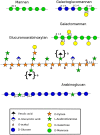
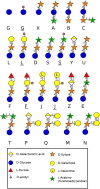
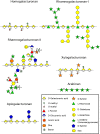
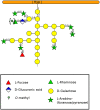
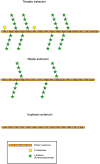
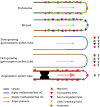
Similar articles
-
Vegetative and reproductive innovations of early land plants: implications for a unified phylogeny.Philos Trans R Soc Lond B Biol Sci. 2000 Jun 29;355(1398):769-93. doi: 10.1098/rstb.2000.0615. Philos Trans R Soc Lond B Biol Sci. 2000. PMID: 10905609 Free PMC article. Review.
-
Cell Wall Composition, Biosynthesis and Remodeling during Pollen Tube Growth.Plants (Basel). 2013 Mar 7;2(1):107-47. doi: 10.3390/plants2010107. Plants (Basel). 2013. PMID: 27137369 Free PMC article. Review.
-
Spatial and Temporal Distribution of Arabinogalactan Proteins during Larix decidua Mill. Male Gametophyte and Ovule Interaction.Int J Mol Sci. 2021 Apr 21;22(9):4298. doi: 10.3390/ijms22094298. Int J Mol Sci. 2021. PMID: 33919026 Free PMC article.
-
The Evolution of Sexual Fluids in Gymnosperms From Pollination Drops to Nectar.Front Plant Sci. 2018 Dec 18;9:1844. doi: 10.3389/fpls.2018.01844. eCollection 2018. Front Plant Sci. 2018. PMID: 30619413 Free PMC article. Review.
-
Developmental evolution of flowering plant pollen tube cell walls: callose synthase (CalS) gene expression patterns.Evodevo. 2011 Jul 1;2(1):14. doi: 10.1186/2041-9139-2-14. Evodevo. 2011. PMID: 21722365 Free PMC article.
Cited by
-
Two Is Company, but Four Is a Party-Challenges of Tetraploidization for Cell Wall Dynamics and Efficient Tip-Growth in Pollen.Plants (Basel). 2021 Nov 5;10(11):2382. doi: 10.3390/plants10112382. Plants (Basel). 2021. PMID: 34834745 Free PMC article. Review.
-
Cell wall polymers in the Phaeoceros placenta reflect developmental and functional differences across generations.Bryophyt Divers Evol. 2021 Jun 30;43(1):265-283. doi: 10.11646/bde.43.1.19. Bryophyt Divers Evol. 2021. PMID: 34532591 Free PMC article.
-
Chitosan stimulates root hair callose deposition, endomembrane dynamics, and inhibits root hair growth.Plant Cell Environ. 2025 Jan;48(1):451-469. doi: 10.1111/pce.15111. Epub 2024 Sep 13. Plant Cell Environ. 2025. PMID: 39267452 Free PMC article.
-
Two Carbohydrate-Based Natural Extracts Stimulate in vitro Pollen Germination and Pollen Tube Growth of Tomato Under Cold Temperatures.Front Plant Sci. 2021 Oct 7;12:552515. doi: 10.3389/fpls.2021.552515. eCollection 2021. Front Plant Sci. 2021. PMID: 34691089 Free PMC article.
-
Combining extracellular matrix proteome and phosphoproteome of chickpea and meta-analysis reveal novel proteoforms and evolutionary significance of clade-specific wall-associated events in plant.Plant Direct. 2024 Mar 18;8(3):e572. doi: 10.1002/pld3.572. eCollection 2024 Mar. Plant Direct. 2024. PMID: 38500675 Free PMC article.
References
-
- Abel W. O., Knebel W., Koop H. U., Marienfeld J. R., Quader H., Reski R., Schnepf E., Sprlein B. (1989). A cytokinin-sensitive mutant of the moss, Physcomitrella patens, defective in chloroplast division. Protoplasma 152, 1–13. 10.1007/BF01354234 - DOI
-
- Anderson J. R., Barnes W. S., Bedinger P. (2002). 2,6-Dichlorobenzonitrile, a cellulose biosynthesis inhibitor, affects morphology and structural integrity of petunia and lily pollen tubes. J. Plant Physiol. 159, 61–67. 10.1078/0176-1617-00651 - DOI
Publication types
LinkOut - more resources
Full Text Sources
Research Materials

